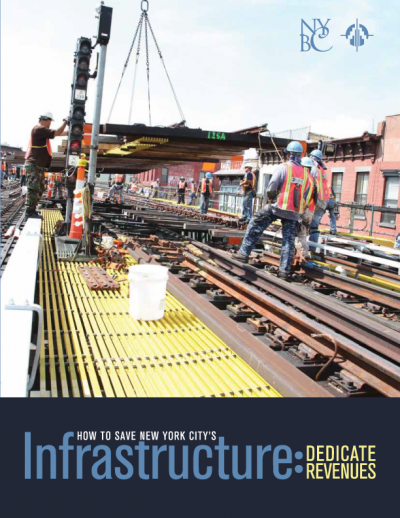
How to Save New York City's Infrastructure: Dedicate Revenues
The Players
Investment in New York City's infrastructure is shared by a number of government entities.
NEW YORK CITY • The City of New York is the single biggest investor in its own infrastructure. In FY 2011, the City spent $9.1 billion to maintain and improve the systems under its control. The largest portion – $3.1 billion – was invested in environmental infrastructure – water, sewers, and sanitation; $2 billion went to public schools; and $1 billion went to transportation. The additional billions went to improve parks, public hospitals, and other government assets, including technology.

The vast majority (95 percent) of the City of New York's capital spending is funded through debt. The City issues a wide variety of bonds, backed primarily by income and property taxes. The large projects for water and sewer improvements deserve special mention, since the borrowing to provide them is supported by a dedicated revenue stream. Individual property owners are assessed charges based on actual water and sewer usage. These revenues are directed to the Water Finance Authority (WFA) and are devoted exclusively to the operations and capital program of the water and sewer system, an arrangement that has enabled the modernization and upkeep of the largest water supply and wastewater treatment systems in the country.
MTA • The state-controlled Metropolitan Transportation Authority (MTA) is responsible for the city subway system, commuter rail, bus service, and nine bridges and tunnels. The MTA spent $4.1 billion on capital improvements within the City in 2011, continuing a 30-year, $90 billion system restoration and modernization. An increasing portion of the MTA capital program is debt financed, backed primarily by rider fares, driver tolls, and a number of dedicated taxes and fees. Direct city and state contributions provide a much smaller share than they used to. The MTA's first two capital campaigns (1982- 1991) relied on debt financing for only 30 percent of its funding; the bulk came from direct federal, state and city subsidies. In contrast, the MTA's 2010-2014 capital program relies almost twice as much on debt financing, at nearly 60 percent.
PORT AUTHORITY • The Port Authority of New York & New Jersey spent $2.8 billion within the City's boundaries in 2011 to maintain and upgrade its airports, ports, bridges and tunnels, bus terminal and PATH rail system, and to rebuild the World Trade Center. To pay for its capital projects, the Port Authority issues bonds backed by tolls, leases, airport fees, and other charges. The Port Authority collects its own revenues, which are protected and used for their intended purpose. These revenues also fund day-to-day operations.
STATE AND FEDERAL GOVERNMENTS • In 2011, the State of New York spent approximately $1.9 billion in the City on State-controlled highways and bridges, institutions of higher education, and environmental infrastructure. The State's spending is largely paid for by bonds issued by various State authorities, State tax revenues, and federal grants. While the federal government directly spent only about $330 million in New York City, it also allocates billions of dollars in grants to several State entities, most notably the MTA.




